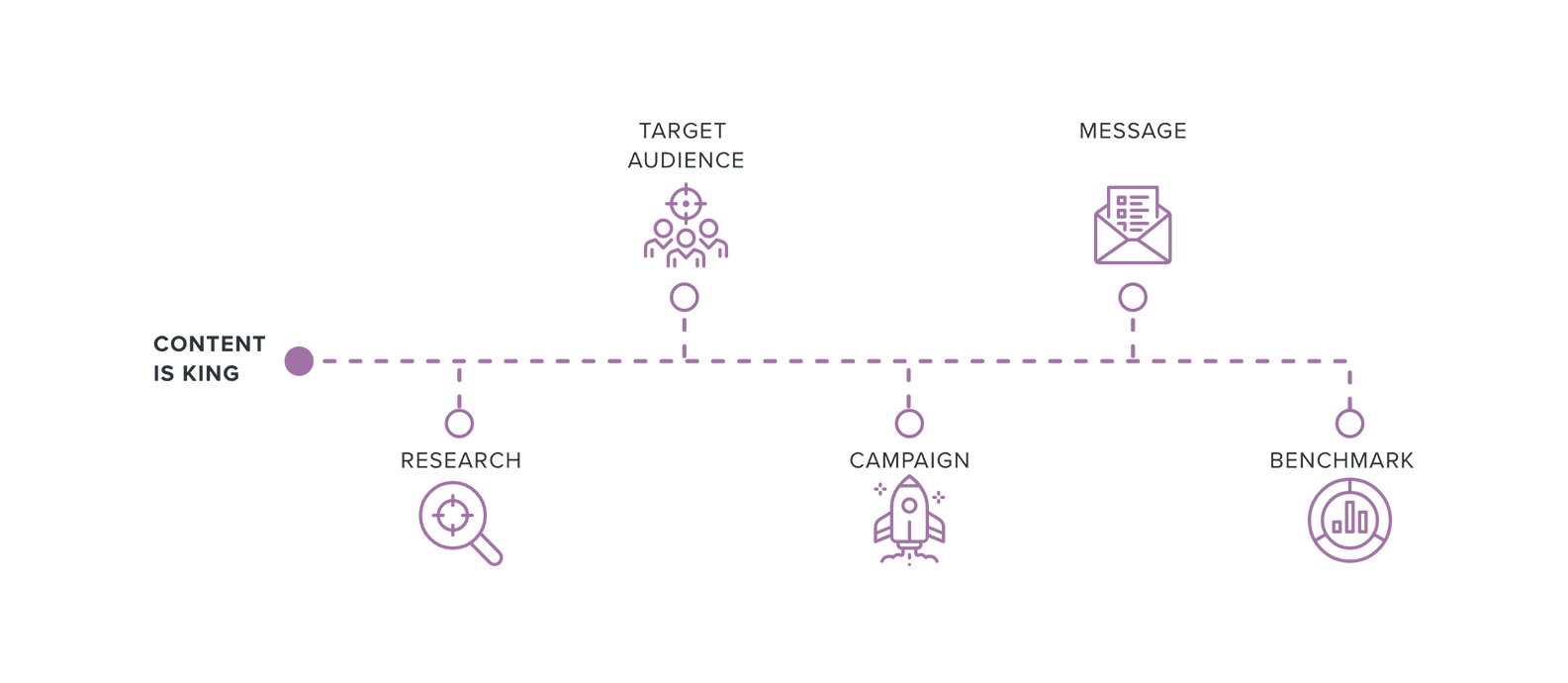As elements of pre-pandemic life begin to return to normal, the B2B tech industry remains under the shadow of the comprehensive changes of the past year. The norms of how we work, live, and communicate were all overturned, and companies continue to make adjustments as we all face an uncertain climate.
To be successful, firms must continue adapting to new ways their prospects receive information and research purchases. Even as some firms have returned to their offices, many others have not, which continues to impact marketing strategies. Traditional media ad spending was down by nearly 40% in 2020, and tech consumption has increased as the digital space has grown more embedded in day-to-day life.
As your firm plans for the future, you need to recognize areas where consumer behavior has changed—possibly for good. By taking advantage of four critical aspects of your marketing efforts, your firm can keep its goals within reach.
1. Content Marketing Remains King in B2B Tech
Long before the pandemic, content marketing provided B2Bs with a crucial means for lead generation and building brand awareness. Through a mix of SEO, consistent publication, and gated assets, your firm’s website becomes a powerful platform to showcase your firm’s value and expertise.
Given the shifts of the past year, your digital outreach has grown that much more critical. With trade shows and in-person networking only tentatively returning, both your business and your prospects remain reliant on the highest-ranked content search results pages. As smart speakers have grown more popular, you also need to ensure that your site is optimized for voice search.
And, once a user arrives at your site, your content must provide a compelling journey to becoming a converted customer.

More Content Leads to More Conversion Opportunities
In the post-pandemic world, regular publication has grown more essential. If a given company was once creating one article per week, that number has now grown to three. Website tools like SEMrush allow you to ensure your firm is using the right keywords to draw more organic traffic to your site through search.
And, once your prospects have found a firm that aligns with their needs, they want to ensure content is delivered to them rather than searching any further. The B2B sales cycle is often long and requires approval from multiple stakeholders. From email subscriptions to downloadable interactive features, you need to ensure your firm provides prospects with the content they want.
2. Mobile Experience Marketing Allows Firms to Respond to ‘Micro-Moments’
The pandemic forced everyone into their homes, which placed more focus on the desktop experience as device usage habits changed. However, as Google effectively underscored with Mobile-First Indexing, your prospects who browse for services on their phones remain equally important.
As described by Google a few years ago, “micro-moments” constitute those brief interactions users have with their phones in response to sudden impulses to learn or explore something. For as much emphasis as firms place on the desktop experience, more and more companies want their mobile sites to be just as impactful to accommodate these micro-moments.
Your mobile site no longer needs to be limited to creating a smaller version of your desktop. During website redesigns, the mobile experience often falls out of scope. As a result, firms will consult a tool like Google’s Page Speed Insights and see high-performance rates for their desktop users while their mobile site experience flounders.

Prioritize the Mobile Audience Across Your B2B Firm’s Digital Channels
How your content and assets display on mobile screens can no longer be an afterthought for any business. Similarly, your social media strategy also needs to reflect the increased use of mobile devices for various platforms.
Social animations, videos, and downloadable assets created specifically for Twitter, LinkedIn, or Instagram provide eye-catching ways to enhance your marketing. For example, the data management firm Cohesity used an infographic to stand out from their audience’s feeds with a report on ransomware recoverability. Instead of posting a standalone link, the firm provided a more engaging asset to drive prospects to their website.
3. Data Analytics Provides Clearer Understanding of Your Customer
Data is everything when it comes to understanding the success of your digital strategy. From tracking email engagement rates to sales funnel performance, analytics tools allow firms to make more informed decisions about their marketing approach.
As the digital space has grown more vital over the past year, more firms have been setting aside separate budgets to support analytics and research. Google Data Studio enables B2B firms to centralize data from multiple sources into a single view.

Predictive Analytics Opens the Door to Website Personalization
When your firm is equipped to capture its user data, you can use predictive analytics to refine your marketing approach. If you create an event in Google Analytics that monitors visits to product or solutions pages, you can use Data Studio to recognize areas of the page that drive conversions. As data shows where your prospects are falling off, you can then adjust the design to deliver better results.
Once you can build predictive models from your user’s habits, you can then incorporate a more personalized experience that reflects their interests. However, collecting your customer’s information constitutes another area where your business needs to remain up-to-date.
4. Consumer Privacy Remains a Focus — and a Moving Target
The passage of Europe’s General Data Protection Regulation (GDPR) and the consumer privacy act (CCPA) of California sent a signal that consumer demands for control over their data was growing. With Google Chrome no longer supporting third-party cookies next year, digital marketers must ensure their websites are in compliance.
However, even as major technology firms are responding to consumer privacy concerns, they’re also developing alternatives for marketers. Google’s Event Conversion Measurement API and Privacy Preserving Ad Click Attribution from Apple remain works in progress. But they should provide alternative ways for your firm to monitor ad performance.
As your firm loses the ability to track user behavior across sites, you need to capture user details that are owned by your site, or first-party data. Users value their privacy, but they also appreciate website personalization. Balancing those competing priorities for your prospects will remain an ongoing challenge.

Demands for Data Security Extend to Your B2B Firm
Relatedly, current events have shown that organizations of all kinds face an ongoing threat of cyberattacks. You need to ensure your site remains current with every patch and security update to prevent ransomware attacks and exposing sensitive data.
In site security and in marketing, best practices shift every year. While the impact of 2020 continues to reverberate, the year ahead may well bring further unexpected shifts. By remaining in tune with your audience—and your competitors—you’ll be in a strong position to keep pace with whatever lies ahead.





